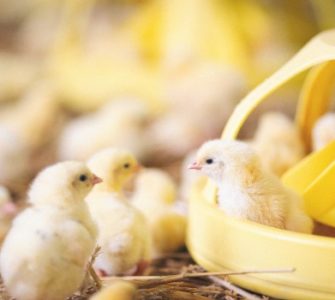Surveillance of circulating IBV types essential for disease control
Surveillance aimed at pinpointing the type of infectious bronchitis virus (IBV) that’s circulating in poultry flocks is essential to control of the disease, Mark Jackwood, PhD, University of Georgia, told Poultry Health Today.
There are a lot of different IBV types circulating in the poultry industry. “So if we don’t know what’s out there, we don’t know which vaccines to pull off the shelf to use…,” he said.
Surveillance isn’t as easy as it seems, however, because IBV doesn’t stay around for very long. Healthy birds without signs of IBV can be infected with the virus, Jackwood said. “We see the virus reaching a very high peak and titer within the bird actually before we see clinical signs. So once we see clinical signs, the virus is starting to go away…and we may be too late to actually catch it.”
Hitting that window of opportunity when the virus is present and taking samples at that particular point can sometimes be a challenge, “so timing is everything,” he said.
To catch the virus when it’s present in high enough concentrations to be detectable, Jackwood advised taking a minimum of 25 samples per house from both sick birds as well as apparently healthy birds.
Fragile virus
The fragility of IBV needs to be considered when obtaining samples, he continued. The virus is very easily destroyed by soap, disinfectants and heat, which on one hand is good news, but samples obtained for testing need to be kept cold, Jackwood cautioned.
“What we’ve found is taking a swab from the choanal cleft, or the split in the roof of the mouth, is the easiest, particularly in a poultry house where there’s low lighting. It’s not real easy to hit the trachea,” he said.
Once that swab is put into transport media, “It needs to stay ice cold, at least ice cold, until it gets back to the lab where we test it. Frozen is even better,” Jackwood advised.
If the sample is allowed to warm up to room temperature for any period of time — even a short period of time — the virus and its RNA will be gone and undetectable, he cautioned, and added that a cooler should be taken into the poultry house when collecting samples.
Sentinel birds
Sampling of flocks is the quickest and easiest way to surveil for IBV types and it’s usually the first approach tried, but sometimes the use of sentinel birds — a more expensive endeavor — is the only way to identify some of the IBV variants that are circulating.
The day sentinels are placed in a flock is the day they are considered infected. Samples from the sentinels are taken 5 and 10 days after placement. “That’s the ideal window from the time they get infected to be able to detect the virus,” Jackwood said.
Sentinel birds can also be vaccinated before they are put in the house. Say flocks are vaccinated with IBV Massachusetts and Arkansas vaccines but birds are sick. “Let’s vaccinate our sentinels with Arkansas and with Massachusetts so that we’re not going to pick up those vaccine viruses. Whatever IBV variant is there will infect the sentinel birds, and it can be identified much easier,” he said.
Using sentinel birds is expensive because specific-pathogen-free birds have to be obtained, they have to be kept in a clean environment while they’re vaccinated and developing immunity, and their use requires planning ahead, Jackwood said.
Moving target
Asked how many strains might be circulating at a time, Jackwood said anywhere from one to six. Currently in Georgia, there are four IBV variants floating around, although they can vary by area. And what was found in north Georgia this spring may not be the same virus that’s going to be there in north Georgia in the fall. That moving target requires constant surveillance, which complicates vaccination planning.
More than one type of IBV vaccine may cross-protect, but what’s difficult is selecting the right combination of commercially available vaccines, he said.
“You can’t just say, ‘Okay, this variant virus that we have, it’s relatively similar genetically…to a vaccine virus that we have — let’s try that one first.’ That’s a logical approach…but we still may not get complete protection,” he said.
If a couple of different vaccines are combined, there may be a broader immune response, but there’s no way to predict what will work. “You have to actually do the vaccine challenge studies in the laboratory to show that it actually will protect,” he said.
Passive versus active surveillance
Jackwood noted there is a difference between passive and active surveillance. “We’re constantly doing passive surveillance” of samples that come to the diagnostic lab at the University of Georgia’s Poultry Diagnostic Research Center. Respiratory cases are tested for IBV.
When a pattern is seen — for instance, a group of variant viruses that are routinely coming in — then active surveillance is initiated. “We’ll actually go out into the field…and survey a wide area to find out how widespread [it is and] how big of a problem it is actually causing our industry,” he said. Active surveillance is usually necessary in spring and fall, when there are big temperature swings, and in winter.
“It’s hard, you know, managing poultry houses when we have big temperature swings like that and, consequently, we see a lot of respiratory [disease] during those times,” Jackwood said.
Posted on July 6, 2020

















